Something nice on it's way.
- BowMan
- One of Us (Nirvana)

- Posts: 446
- Joined: Mon Feb 06, 2012 7:09 pm
Re: Something nice on it's way.
There are good bows and then there is art....
This one is just lovely. It's good good brace height so it seems its build for accuracy and not speed. I can also see rosewood and a lighter core wood reinforced with fibre. I also noticed that the arrow shelf is on the left so does that make you a lefty?
Tell us more about the bow and the bowyer.
This one is just lovely. It's good good brace height so it seems its build for accuracy and not speed. I can also see rosewood and a lighter core wood reinforced with fibre. I also noticed that the arrow shelf is on the left so does that make you a lefty?
Tell us more about the bow and the bowyer.
Last edited by BowMan on Mon Jan 14, 2013 10:52 pm, edited 1 time in total.
-
Mack The Knife
- We post a lot

- Posts: 5775
- Joined: Mon May 22, 2006 6:23 pm
Re: Something nice on it's way.
See the first post for the specificatons. 
If you like the looks of this bow, you will like my first BamaBows longbow even more. Almost the same, except that it has some Amazon Bloodwood in it.
On this one, the riser is cocobolo, the limbs of tempered bamboo and backed and faced with black fibreglass. Tips are black phenolic and cocobolo.
A Hill style stickbow isn't a speed demon and yet they have managed to take down the African Big Five since the 1950's.
Right handed archers shoot the arrow off the left.
You can read about the bowyer and see his work at http://www.bamabows.com/aboutus.html (There is also a link to an interview.)
As for the bow, it is the style popularised by Howard Hill and is known as the Hill style longbow or American semi-long bow.
When researching my first custom longbow, I settled on Nate as my bowyer as I read nothing but praise for him and his work and his price was reasonable. Thanks to Inder's help with PayPal, I was able to pay for my BamaBows Hunter in stages. During this period we became good friends and since he also angles we have been in almost weekly touch with each other ever since. A few months after receiving my Hunter, he siad he was going to send me a bow. I thought, and was hoping, it would be a simple selfbow. He wouldn't tell me what it was but he did mention the specs. A little snooping around on his website and I came across his personal Expedition (a deflex-reflex bow) which matched the specs. Last bow here - http://www.bamabows.com/expedition.html This bow costs close to $900.00 but being the blunt SOB that I am, I told him I did not like it and I wouldn't be caught dead with an aggressive D-R bow like that, however efficient it may be. At that time his longbows weren't strictly Hill style bows, so I pestered him into building them and offered to be a guinea pig.
Unknown to Nate and he still does not know, I am also on very good terms with one of THE Hill style bowyers currently alive. He's from Oz and that's all I am saying. He helped me fine tune the specs and Nate did the rest.
Considering Howard Hill came from the same state as Nate, viz. Alabama, I thought it would be fitting to call this line of bows BamaBows Tribute.
At present Nate is not building the Tribute on a commercial basis as he is still experimenting.
If you like the looks of this bow, you will like my first BamaBows longbow even more. Almost the same, except that it has some Amazon Bloodwood in it.
On this one, the riser is cocobolo, the limbs of tempered bamboo and backed and faced with black fibreglass. Tips are black phenolic and cocobolo.
A Hill style stickbow isn't a speed demon and yet they have managed to take down the African Big Five since the 1950's.
Right handed archers shoot the arrow off the left.
You can read about the bowyer and see his work at http://www.bamabows.com/aboutus.html (There is also a link to an interview.)
As for the bow, it is the style popularised by Howard Hill and is known as the Hill style longbow or American semi-long bow.
When researching my first custom longbow, I settled on Nate as my bowyer as I read nothing but praise for him and his work and his price was reasonable. Thanks to Inder's help with PayPal, I was able to pay for my BamaBows Hunter in stages. During this period we became good friends and since he also angles we have been in almost weekly touch with each other ever since. A few months after receiving my Hunter, he siad he was going to send me a bow. I thought, and was hoping, it would be a simple selfbow. He wouldn't tell me what it was but he did mention the specs. A little snooping around on his website and I came across his personal Expedition (a deflex-reflex bow) which matched the specs. Last bow here - http://www.bamabows.com/expedition.html This bow costs close to $900.00 but being the blunt SOB that I am, I told him I did not like it and I wouldn't be caught dead with an aggressive D-R bow like that, however efficient it may be. At that time his longbows weren't strictly Hill style bows, so I pestered him into building them and offered to be a guinea pig.
Unknown to Nate and he still does not know, I am also on very good terms with one of THE Hill style bowyers currently alive. He's from Oz and that's all I am saying. He helped me fine tune the specs and Nate did the rest.
Considering Howard Hill came from the same state as Nate, viz. Alabama, I thought it would be fitting to call this line of bows BamaBows Tribute.
At present Nate is not building the Tribute on a commercial basis as he is still experimenting.
-
Mack The Knife
- We post a lot

- Posts: 5775
- Joined: Mon May 22, 2006 6:23 pm
Re: Something nice on it's way.
Some pics of my first BamaBows. It's a 2-piece take-down bow.
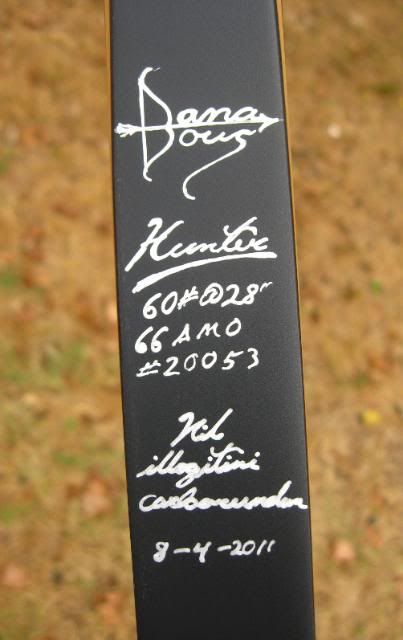

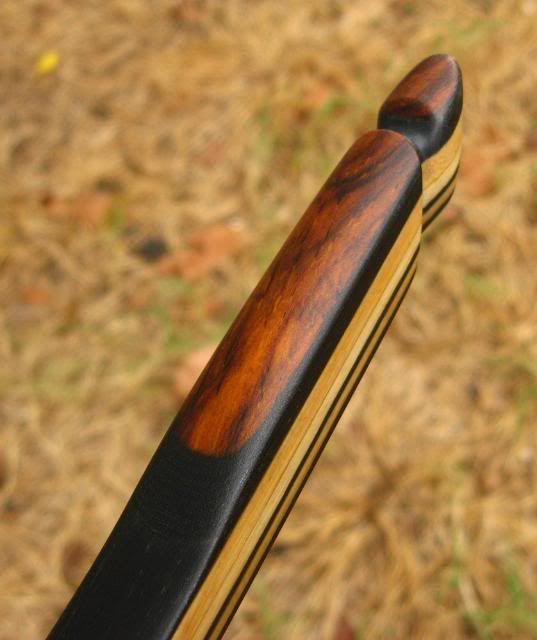
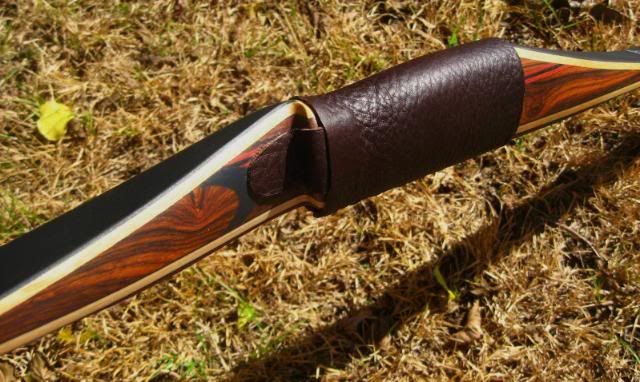
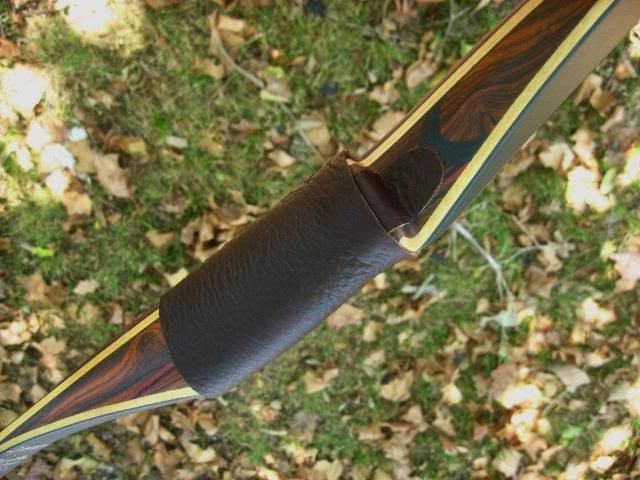
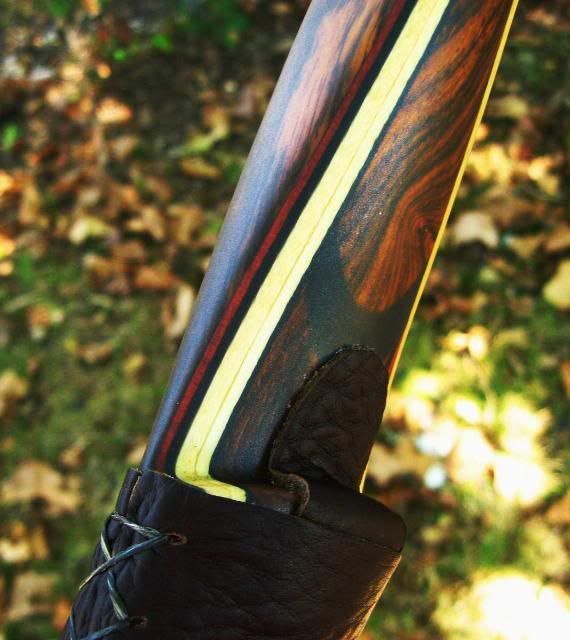
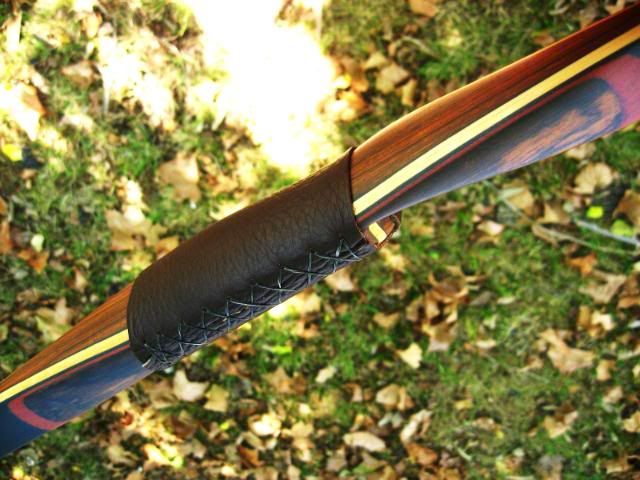









- BowMan
- One of Us (Nirvana)

- Posts: 446
- Joined: Mon Feb 06, 2012 7:09 pm
Re: Something nice on it's way.
Very good indeed Mack. I am surprised your Bowyer seems to be a young chap. I had imagined an old man with a white flowing beard having the accumulated wisdom of a hundred generations.
My bad about the left right confusion.
If I am correct the American and English style longbows differ in that the English one has a D section while yours has a rectangle. Is that correct and are there any more diffrences? Have you shot both (the Americans claim their design in more efficient but the English still cling on)? What are your impressions?
My bad about the left right confusion.
If I am correct the American and English style longbows differ in that the English one has a D section while yours has a rectangle. Is that correct and are there any more diffrences? Have you shot both (the Americans claim their design in more efficient but the English still cling on)? What are your impressions?
-
Mack The Knife
- We post a lot

- Posts: 5775
- Joined: Mon May 22, 2006 6:23 pm
Re: Something nice on it's way.
The old guy, with the white beard and accumulated wisdom lives in Oz and guess what they call him? 
Nate is very good though and very highly regarded by those who have literally had scores of bows pass through their hands from the very best bowyers in the U.S..
Yes, the American Flat Longbow (AFL), including the American semi-long bow, have a rectangular cross-section, whilst the English longbow (ELB) and English warbow (EWB) have a D cross-section. This was done so as to make most use of the Yew trunk they were made from. However, that's a topic for another post. The AFL have a distinct handle (the riser), whilst the ELB and EWB do not. When drawn, the latter two will bend through the handle (bending full compass), whilst the AFL will not, especially if it is a laminated AFL. The AFL usually has an arrow shelf cut into the riser, whilst the ELB and EWB are shot off the bow hand. ELBs and EWBs are invariably a lot longer than AFLs. Last but not least the AFL is drawn to the corner of the mouth, whilst the ELB and EWB are drawn to the ear or a little beyond. What most people do not know is that the English also built and used flat bows during the same period the ELB and EWB were at the height of their importance - the medieval ages. The EWB was the machine gun of it's time as the French found out at the cost of their nobility at Crecy, Poitiers and Agincourt during the Hundred Years War between England and France and their respective allies.
I have never shot or even seen an ELB or EWB (the original and true longbows) but I am lead to beileve that the AFL is more efficient of the two types.
The English aren't clinging on to their D section bows, it's just that there is a lot of renewed interest in these ancient bows and not just in the U.K. but in Oz, NZ and the U.S. as well. Until Howard came along, U.S. archers such as the Maurice brothers, Compton, Pope, Young, etc. used the D section longbows.
Nate has been toying with the idea of building a laminated ELB or EWB for 18 months or so and I hope he gets down to it soon because I definitely want one.
For The Love Of The English Longbow -
And if you want to Hit 'em Like Howard Hill, study the four segments of this video by John Schulz - http://archeryduns.webs.com/apps/videos ... w/14895607
Nate is very good though and very highly regarded by those who have literally had scores of bows pass through their hands from the very best bowyers in the U.S..
Yes, the American Flat Longbow (AFL), including the American semi-long bow, have a rectangular cross-section, whilst the English longbow (ELB) and English warbow (EWB) have a D cross-section. This was done so as to make most use of the Yew trunk they were made from. However, that's a topic for another post. The AFL have a distinct handle (the riser), whilst the ELB and EWB do not. When drawn, the latter two will bend through the handle (bending full compass), whilst the AFL will not, especially if it is a laminated AFL. The AFL usually has an arrow shelf cut into the riser, whilst the ELB and EWB are shot off the bow hand. ELBs and EWBs are invariably a lot longer than AFLs. Last but not least the AFL is drawn to the corner of the mouth, whilst the ELB and EWB are drawn to the ear or a little beyond. What most people do not know is that the English also built and used flat bows during the same period the ELB and EWB were at the height of their importance - the medieval ages. The EWB was the machine gun of it's time as the French found out at the cost of their nobility at Crecy, Poitiers and Agincourt during the Hundred Years War between England and France and their respective allies.
I have never shot or even seen an ELB or EWB (the original and true longbows) but I am lead to beileve that the AFL is more efficient of the two types.
The English aren't clinging on to their D section bows, it's just that there is a lot of renewed interest in these ancient bows and not just in the U.K. but in Oz, NZ and the U.S. as well. Until Howard came along, U.S. archers such as the Maurice brothers, Compton, Pope, Young, etc. used the D section longbows.
Nate has been toying with the idea of building a laminated ELB or EWB for 18 months or so and I hope he gets down to it soon because I definitely want one.
For The Love Of The English Longbow -
And if you want to Hit 'em Like Howard Hill, study the four segments of this video by John Schulz - http://archeryduns.webs.com/apps/videos ... w/14895607
-
Sakobav
- Old Timer

- Posts: 2973
- Joined: Wed May 31, 2006 7:28 pm
- Location: US
Re: Something nice on it's way.
Congrats mack looks great now some more pictures in action
-
Mack The Knife
- We post a lot

- Posts: 5775
- Joined: Mon May 22, 2006 6:23 pm
Re: Something nice on it's way.
Thanks Navi. Got way to much on my mind and I don't like shooting when I am pre-occupied. Action pics will have to wait. Haven't even strung up Naughty Fellow the past few days. 
I have already started pestering Nate to start building laminated English bows. Tempted to go for a 100 lb. draw weight and use that as my exercise bow. All depends on what he prices it at.
Just for the heck of it, I would definitely like to hit 100# draw weight before I turn 50 but cannot afford to do it in 5# increments. I do know of a guy who went from a medium weight bow to a 100# bow, without buying bows in the intermediate weights. However, at that poundage one needs to practice regularly or it takes a week or so to be able to shoot the higher poundages. Lot's to think about - injury, getting wooden arrows in that spine, etc.
I have already started pestering Nate to start building laminated English bows. Tempted to go for a 100 lb. draw weight and use that as my exercise bow. All depends on what he prices it at.
Just for the heck of it, I would definitely like to hit 100# draw weight before I turn 50 but cannot afford to do it in 5# increments. I do know of a guy who went from a medium weight bow to a 100# bow, without buying bows in the intermediate weights. However, at that poundage one needs to practice regularly or it takes a week or so to be able to shoot the higher poundages. Lot's to think about - injury, getting wooden arrows in that spine, etc.
- Moin.
- Poster of the Month - Sep '11 & Apr '13

- Posts: 1718
- Joined: Fri May 07, 2010 11:10 am
- Location: Gujrat
Re: Something nice on it's way.
Hi Mack; Just out of curiosity what is the maximum poundage pratical on these bows. What would have been the poundage required in English Bows to pierce the heavy armours the knights wore during medevil times. What is the effective range of these higher poundage bows and what's required to take down an animal as large as a buffalo with a long bow. I could'nt really beleive this till I saw some pics on the net with animals as large and dangerous like cape buffalo's taken with a bow and arrow.
Your disdian for these compound bows is more because of the love for traditional way of doing things or is there a technical reason behind it. Curiosity killed the cat, but I'll ask anyways

Best
Moin.
Your disdian for these compound bows is more because of the love for traditional way of doing things or is there a technical reason behind it. Curiosity killed the cat, but I'll ask anyways
Best
Moin.
In the depth of winter, I finally learned that within me there lay an invincible summer. Camus
- BowMan
- One of Us (Nirvana)

- Posts: 446
- Joined: Mon Feb 06, 2012 7:09 pm
Re: Something nice on it's way.
Good question. Lets also include composite bows because a vast majority of ancient armies did not use longbows but used composite bows.What would have been the poundage required in English Bows to pierce the heavy armours
-
Skyman
- Shooting true

- Posts: 975
- Joined: Fri Jan 27, 2012 1:29 pm
Re: Something nice on it's way.
AKAIK the draw weights on English bows varied from 80-100 pounds.Though there are specimens of 180 pounds and more.The penetration depended on the kind of arrow used, and varied from 0.25 to 1 in.
I reckon 80 pounds would have been sufficient to pierce plate armor 0.25 an inch or more.
I reckon 80 pounds would have been sufficient to pierce plate armor 0.25 an inch or more.
I would rather hit my target gently than miss hard.
- BowMan
- One of Us (Nirvana)

- Posts: 446
- Joined: Mon Feb 06, 2012 7:09 pm
Re: Something nice on it's way.
I guess there have been lots of studies on the effectiveness of bows against armour. Here is one that seems to suggest 3" penetration on Riveted Maille (chain mail) which is very good quality armour;
http://www.currentmiddleages.org/artsci ... esting.pdf
Lets keep in mind that full steel plate armour came into battlefields pretty late (it was rendered ineffective sooner by advent of firearms) and possibly a few warriors could afford armour of the best quality. This meant there were always a few exposed areas where there was no armour or less armour. Good archers would always want to pick out such spots on their opponents (there are some references to this in Mahabharata).
Also a video of tests on plate armour;
We need to keep in mind that the study is carried out using a 75 pound bow. However bows discovered on the sunken ship Mary Rose draw 98 pounds to 185 pounds at 30"! This means much more penetration. No knight would like to be shot at by an archer at close to medium ranges.
The composite archers too managed to draw bows accurately which appears superhuman to present day keyboard punchers. Most experts point to draw weights which are comparable to the longbows on Mary Rose. I remember reading an article in Nat Geo a very very long time back about a nomadic warrior who lay frozen in his death and there were many artefacts discovered on his body including a composite bow which if I remember correctly weighed in close to 200 pounds (I will try to find this article and post it).
http://www.currentmiddleages.org/artsci ... esting.pdf
Lets keep in mind that full steel plate armour came into battlefields pretty late (it was rendered ineffective sooner by advent of firearms) and possibly a few warriors could afford armour of the best quality. This meant there were always a few exposed areas where there was no armour or less armour. Good archers would always want to pick out such spots on their opponents (there are some references to this in Mahabharata).
Also a video of tests on plate armour;
We need to keep in mind that the study is carried out using a 75 pound bow. However bows discovered on the sunken ship Mary Rose draw 98 pounds to 185 pounds at 30"! This means much more penetration. No knight would like to be shot at by an archer at close to medium ranges.
The composite archers too managed to draw bows accurately which appears superhuman to present day keyboard punchers. Most experts point to draw weights which are comparable to the longbows on Mary Rose. I remember reading an article in Nat Geo a very very long time back about a nomadic warrior who lay frozen in his death and there were many artefacts discovered on his body including a composite bow which if I remember correctly weighed in close to 200 pounds (I will try to find this article and post it).
-
Mack The Knife
- We post a lot

- Posts: 5775
- Joined: Mon May 22, 2006 6:23 pm
Re: Something nice on it's way.
Hi Mack; Just out of curiosity what is the maximum poundage pratical on these bows.
What type of bow are you refering to and practical for what? Target, hunting or battle?
What would have been the poundage required in English Bows to pierce the heavy armours the knights wore during medieval times.
120 to 140# is believed to be the average draw weight used by the longbowmen. Some shot less than 120# and some shot over 140#. As per the bows found on Henry VIII sunken flagship, the Mary Rose, bows between 80 and 180# were retrieved. The bodkin tipped (not broadhead tipped) arrows could only pierce armour at close range. I am talking about the very best armour that was available then - mainly from Milan, probably some parts of Germany, Bordeaux (under English rule) and perhaps southern France. Not sure about the last. Maybe even Spain. For obvious reasons, only the nobility could afford such expensive armour. However, the horses on which the knights and their squires were mounted, though armoured, were very susceptible to arrow hits. Once a knight or squire was unhorsed, he found it extremely difficult to move, especially through the quagmire that was Agincourt on that fateful day - 25th October, 1415. My birthday, barring the year.
To start with, the English longbowmen used flight arrows (I think that's what they were called) to deceive the French and their allies into believing that they were in range. Whereupon the crossbowmen would open fire and waste their bolts as the English were actually out of range. The English longbowman was trained to loose (archery term for 'fire') 12 to 15 arrows per minute. However, this rate of fire was only used when the enemy was close at hand, as the English had to save their arrows. Even though the English had tens of thousands of arrows, they did run out of arrows, at which time the longbowman was obliged to draw his short sword, axe, etc. and join the melee.
Approximately 200 to 400 yards for the English Warbow depending on the bow's draw weight and the weight of the arrow.What is the effective range of these higher poundage bows and what's required to take down an animal as large as a buffalo with a long bow.
I believe you are now refering to the American semi-long bow or Hill style bow. This is not the same as the English longbow or warbow. In which case, a minimum draw weight of 80# and an arrow weighing atleast 900 grains is recommended. There are lighter poundage bow designs that are more efficient and they have killed Cape Buffalo and even tthe tougher water buffalo but a heavy arrow is mandatory. Needless to say, shot placement, a straight flying arrow, robust and razor sharp broadheads are just as important.
The American semi-long bow has been taking down the African Big Five since the 1950s.I could'nt really beleive this till I saw some pics on the net with animals as large and dangerous like cape buffalo's taken with a bow and arrow.
Both and the challenge of learning a new skill. I have tried the compound arrow launching deviceYour disdian for these compound bows is more because of the love for traditional way of doing things or is there a technical reason behind it. Curiosity killed the cat, but I'll ask anyways
-
Mack The Knife
- We post a lot

- Posts: 5775
- Joined: Mon May 22, 2006 6:23 pm
Re: Something nice on it's way.
By and large, the composite bow, due to it's design and construction, was found to be more efficient than the English longbow and warbow.Good question. Lets also include composite bows because a vast majority of ancient armies did not use longbows but used composite bows.
P.S.: A longbow can also be made as a composite bow.
-
Mack The Knife
- We post a lot

- Posts: 5775
- Joined: Mon May 22, 2006 6:23 pm
Re: Something nice on it's way.
Since they drew to their ears, a shaft length of 30" would be the bare minimum.However bows discovered on the sunken ship Mary Rose draw 98 pounds to 185 pounds at 30"!
I think you are refering to Otzi. He was in the process of making the longbow when he died (probably murdered). Also, the bow was broken when they began exhuming the body. 200# sounds very doubtful.I remember reading an article in Nat Geo a very very long time back about a nomadic warrior who lay frozen in his death and there were many artefacts discovered on his body including a composite bow which if I remember correctly weighed in close to 200 pounds (I will try to find this article and post it).
- Moin.
- Poster of the Month - Sep '11 & Apr '13

- Posts: 1718
- Joined: Fri May 07, 2010 11:10 am
- Location: Gujrat
Re: Something nice on it's way.
Mack The Knife wrote:Hi Mack; Just out of curiosity what is the maximum poundage pratical on these bows.
What type of bow are you refering to and practical for what? Target, hunting or battle?
What would have been the poundage required in English Bows to pierce the heavy armours the knights wore during medieval times.
120 to 140# is believed to be the average draw weight used by the longbowmen. Some shot less than 120# and some shot over 140#. As per the bows found on Henry VIII sunken flagship, the Mary Rose, bows between 80 and 180# were retrieved. The bodkin tipped (not broadhead tipped) arrows could only pierce armour at close range. I am talking about the very best armour that was available then - mainly from Milan, probably some parts of Germany, Bordeaux (under English rule) and perhaps southern France. Not sure about the last. Maybe even Spain. For obvious reasons, only the nobility could afford such expensive armour. However, the horses on which the knights and their squires were mounted, though armoured, were very susceptible to arrow hits. Once a knight or squire was unhorsed, he found it extremely difficult to move, especially through the quagmire that was Agincourt on that fateful day - 25th October, 1415. My birthday, barring the year.
To start with, the English longbowmen used flight arrows (I think that's what they were called) to deceive the French and their allies into believing that they were in range. Whereupon the crossbowmen would open fire and waste their bolts as the English were actually out of range. The English longbowman was trained to loose (archery term for 'fire') 12 to 15 arrows per minute. However, this rate of fire was only used when the enemy was close at hand, as the English had to save their arrows. Even though the English had tens of thousands of arrows, they did run out of arrows, at which time the longbowman was obliged to draw his short sword, axe, etc. and join the melee.
Approximately 200 to 400 yards for the English Warbow depending on the bow's draw weight and the weight of the arrow.What is the effective range of these higher poundage bows and what's required to take down an animal as large as a buffalo with a long bow.
I believe you are now refering to the American semi-long bow or Hill style bow. This is not the same as the English longbow or warbow. In which case, a minimum draw weight of 80# and an arrow weighing atleast 900 grains is recommended. There are lighter poundage bow designs that are more efficient and they have killed Cape Buffalo and even tthe tougher water buffalo but a heavy arrow is mandatory. Needless to say, shot placement, a straight flying arrow, robust and razor sharp broadheads are just as important.
The American semi-long bow has been taking down the African Big Five since the 1950s.I could'nt really beleive this till I saw some pics on the net with animals as large and dangerous like cape buffalo's taken with a bow and arrow.
Both and the challenge of learning a new skill. I have tried the compound arrow launching deviceYour disdian for these compound bows is more because of the love for traditional way of doing things or is there a technical reason behind it. Curiosity killed the cat, but I'll ask anyways
and it left me yearning for much more. I also like pulling certain legs on this forum.
Thanks Mack for the detailed reply. I meant what is the maximum poundage possible on the hand built bow like yours and which can be handled by an average joe and don't need muscles the size of Arnold....
Regards
Moin
In the depth of winter, I finally learned that within me there lay an invincible summer. Camus



